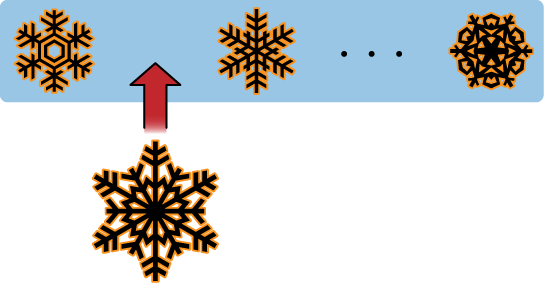MongoDB权威指南(3)- Querying
1.find方法介绍
在不传入参数的情况下,find方法缺省使用{}做参数,它匹配所有的document。
我们可以传入一个查询document给find方法来限制输出,如:查找年龄为27的用户
一个查询document里可以包括多个条件,如:查询年龄为27并且名字叫joe的用户
条件之间都是And关系。
指定查询返回的内容
有时候我们并不需要返回document里所有的key/value对,我们可以给find(或findOne)方法传入第二个参数来指定返回哪些key的值。
比如:我们只想要用户的名字和Email
{
" _id " : ObjectId( " 4ba0f0dfd22aa494fd523620 " ),
" username " : " joe " ,
" email " : " [email protected] "
}
"_id"键总是会被返回。
如果想指定不想返回的key,如:返回除了fatal_weakness以外的key的值
用这个方法可以把缺省返回的"_id"给排除掉
{
" username " : " joe " ,
}
限制
查询document里边key的值对数据库来说必须是个常量,假如collection里边有两个key,一个叫int_stock一个叫num_sold,
如果我们想查询这两个key相等的document,下边的查询是行不通的
2.查询条件
"$lt", "$lte", "$gt", 和"$gte"分别对应<,<=,>,>=
如:查询年龄在18到30之间的用户
“$ne" 不等于,可以用于任意类型的数据
如,查找名字不叫joe的用户
OR查询
mongoDB里有两种使用OR的方法,如果是一个key对应的多个值,可以用"$in",还有个”or"是一种更通用的方法。
如:我们在进行一个抽奖活动,ticket No是725,542,390的三个中奖了,我们可以这样把这三个document查出来
"$in"里边指定的值可以是不同的数据类型
与"$in"相反的操作就是"$nin”,返回指定的key的值不存在于数组里边的document,
上边的查询返回没中奖的所有ticket。
如果要在多个key的查询条件之间建立Or关系就得用"$or",如,查询彩票号码为725, 542, 390 或者winner为true的document
$not
"$not"可以应用于上边说的所有的条件操作符上,举个例子之前我们先看下求余(取模)操作符"$mod","$mod"指定一个整数数组做为key的值,
里边两个数字,第一个是对其求余的数字,第二个是余数。比如,我们要找id_num的值对5求余,余数为1的document
现在我们使用$not,如果找id_num对5求余后余数不为1的document
规律
回头再看下前一章的更新修饰符,就会发现同样是$打头的符号,它和本章说的查询条件符号的位置是不一样的,
在查询里,"$lt"属于内层document,而更新的时候"$inc"是外层document的key。
一个key上可以有多个查询条件,却不能有多个更新。
查询年龄为20到30的用户可以这样做
但是却没有下边这种更新修饰符
3.特殊类型查询
null
null同时匹配自身和不存在的key,
{ " _id " : ObjectId( " 4ba0f0dfd22aa494fd523621 " ), " y " : null }
{ " _id " : ObjectId( " 4ba0f0dfd22aa494fd523622 " ), " y " : 1 }
{ " _id " : ObjectId( " 4ba0f148d22aa494fd523623 " ), " y " : 2 }
如果要查找y为null的document
{ " _id " : ObjectId( " 4ba0f0dfd22aa494fd523621 " ), " y " : null }
查找key为null的document时,缺少此key的所有document也会返回
{ " _id " : ObjectId( " 4ba0f0dfd22aa494fd523621 " ), " y " : null }
{ " _id " : ObjectId( " 4ba0f0dfd22aa494fd523622 " ), " y " : 1 }
{ " _id " : ObjectId( " 4ba0f148d22aa494fd523623 " ), " y " : 2 }
如果想查找key存在并且为null的document,就要用"$exists"符号,
这个办法看起来比较笨,没办法,我们没有"$eq"条件符号。
正则表达式
查找名字叫joe,但是忽略大小写的document
mongoDB使用Perl Compatible Regular Expression (PCRE)来匹配正则表达式,所有PCRE允许的语法都可以在mongoDB里使用。
查询数组
查询数组很简单,通常情况下,数组的每个元素的值都能看作key的值。
例如,我们有一些水果
我们查找水果里有香蕉的ducoment
用起来就好像我们有这么一个document在
当然,上边这个document是不合法的。
$all
如果要匹配数组里的多个元素,就要用“$all”。
例如,我们有这样一个collection
> db.food.insert({ " _id " : 2 , " fruit " : [ " apple " , " kumquat " , " orange " ]})
> db.food.insert({ " _id " : 3 , " fruit " : [ " cherry " , " banana " , " apple " ]})
要查询既有apple又有banana的document
{ " _id " : 1 , " fruit " : [ " apple " , " banana " , " peach " ]}
{ " _id " : 3 , " fruit " : [ " cherry " , " banana " , " apple " ]}
$all的值里边的元素是没有顺序的,只要目标包含里边的每个元素即可,如果不使用$all,就会执行精确的匹配检查。
上边这个查询会匹配第一个document
这个查询就不会匹配第一个document
同样,这个查询也不会匹配第一个document
如果要匹配数组里指定的元素,就要使用key.index这种语法
index 是从0开始索引的
$size
按照数组中元素的个数查询
$size 不能和比较条件符号(如$gt)联合使用
$slice操作符
上边曾经提到过,使用find方法的第二个参数,指定哪些键值会被返回,$slice操作符可以返回数组元素的一个子集。
例如,查找博客和它的前10条评论
或者,如果想要后10条评论的话
也可以返回中间的一段结果
上边的查询跳过前23个元素,返回第24个到第34个元素。
查询嵌入的document
查询嵌入的整个document和普通的查询没有差别,比如我们有这样一个document
" name " : {
" first " : " Joe " ,
" last " : " Schmoe "
},
" age " : 45
}
那么我们就可以这样查询名字叫Joe Schmoe的人
如果Joe要加一个middle name,这个查询就不行了,这种查询必须匹配整个嵌入的document,而且key是有顺序的。
我们可以用.来直接查询嵌入的key。
点号在查询用document里就被解释为“通向嵌入的document”,所以document的key里边不能包含点号。
$where 查询
$where子句允许你在查询里执行arbitary javascript,使你几乎可以在查询中做任何事情。
最常见的例子就是比较document里边两个key的值。举个例子,我们有个list,我们想返回里边的key的值里有相等的document
(随便哪两个key,只要它们的value相等即可)。
> db.foo.insert({ " apple " : 8 , " spinach " : 4 , " watermelon " : 4 })
第二个document里,菠菜和西瓜的值是相等的,这个应该返回,这个使用$条件查询符号是做不到的。
... for ( var current in this ) {
... for ( var other in this ) {
... if (current != other && this [current] == this [other]) {
... return true ;
... }
... }
... }
... return false ;
... }});
如果函数返回true,那么这个document就会作为结果集的一部分被返回。
刚才我们定义了一个函数,给$where查询指定一个字符串是一样的效果
> db.foo.find({ " $where " : " function() { return this.x + this.y == 10; } " })
这两个查询是等价的。
如非必要,尽量不要使用$where查询,$where查询比一般的查询慢很多,每个document都必须从BSON转换为一个javascript对象,
然后执行$where表达式。而且,索引也不能使用。你可以通过组合使用$where查询和非$where查询来降低使用它的代价。
4.游标
find方法使用游标返回查询结果,游标的客户端实现使你可以对最终结果做很多的控制。在shell里创建一个游标很简单,往collection里放些document,
执行查询,将返回结果指派给一个本地变量即可。
... db.c.insert({x : i});
... }
> var cursor = db.collection.find();
你可以使用next方法来遍历结果,使用hasNext方法来检查有没有下一个,典型的循环如下
... obj = cursor.next();
... // do stuff
... }
cursor类同样实现了iterator接口,所以你可以使用forEach循环
> cursor.forEach( function (x) {
... print(x.name);
... });
adam
matt
zak
当你调用find方法的时候,shell并不会立刻去查询数据库,直到你真正请求结果的时候才发送查询,这样你可以在实际执行查询之前
追加一些其他的选项,游标的这些方法几乎都是返回游标本身,所以你可以按任意顺序链入这些方法,下边三个查询是等价的
> var cursor = db.foo.find().limit( 1 ).sort({ " x " : 1 }).skip( 10 );
> var cursor = db.foo.find().skip( 10 ).limit( 1 ).sort({ " x " : 1 });
在这个时候查询并未执行,所有的函数都只是构建查询。现在我们调用hasNext方法,
这时候查询被送到服务器,shell就立刻取到了前100条结果或者前4MB的结果,所以接下来在调用next方法的时候就不会再发送请求
以及接受结果,当第一次返回的结果集用完的时候,shell会再次联系服务器,请求更多的结果。
Limits, Skips, 和Sorts
limit函数限制返回的结果集的上限,如,只返回3个结果
skip函数跳过前x个结果,返回剩余的
sort方法使用一组键值对做参数,key是document里的key的名字,value是1升序或者-1降序。
如,按名字升序和年龄降序排序
比较顺序
mongoDB有一个关于各种数据类型之间比较的等级制度。在某些情况下,你可能有一个key,它的值有多种类型,如果你想按照该
key排序,mongoDB有一个预定义好的顺序,它们从小到大分别为:
1. Minimum value
2. null
3. Numbers (integers, longs, doubles)
4. Strings
5. Object/document
6. Array
7. Binary data
8. Object ID
9. Boolean
10. Date
11. Timestamp
12. Regular expression
13. Maximum value
获取一致性的结果
处理数据的常见方式就是从mongoDB里取出来,然后修改它,再存储进mongoDB,如下:
while (cursor.hasNext()) {
var doc = cursor.next();
doc = process(doc);
db.foo.save(doc);
}
结果集数量很小的时候,这样子做是没问题的,如果结果集很大,这个做法就行不通了。
想象一下document是如何存储的,你可以像下图4-1一样来理解存储document的collection,每个雪花代表一个document,因为
它们和document一样,都很漂亮而且独一无二。
图4-1
现在,我们执行一个find,它从头开始向右返回结果。程序获取前100个document并处理它们,然后将它们存储回数据库,如果一个
document没有足够的空间来容纳新的document,如图4-2,那么就需要给它重新指定存储位置。通常,这个新的document 会重新
定位到collection的尾部,如图4-3.
图4-2
图4-3
现在,我们的程序持续不断地批量获取document,当它到达collect尾部的时候,那些被重新定位的document会再次返回,如图4-4.
图4-4
这个问题的解决办法是,对查询使用snapshot,如果添加了“$snapshot"选项,查询就会按照collection未被改变的视图运行。



